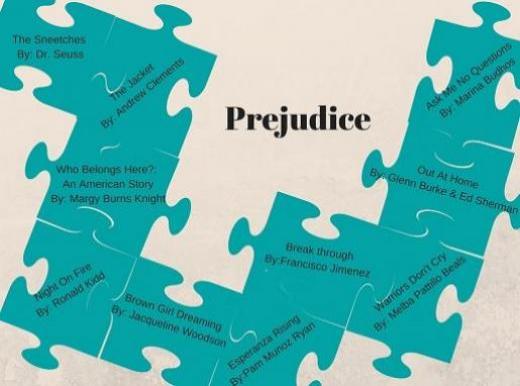
Dear Teacher,
Prejudice is a very common theme in society and in the classroom. At a young age, children become very aware of how they are different from others and how others are different from them. It is also common for others to be teased for being different. Prejudice starts at such a young age and when they are that young they may not know whether someone is being prejudice or what that is. I think it is an important topic to teach in the classroom because children should be aware of what being prejudice means and what it looks like. I also believe that when you teach about prejudice, it is also important to teach about acceptance.
Attached above, I have designed a reading ladder on a theme, prejudice. On this reading ladder I have suggested some texts that touch on this theme. This reading ladder consists of a range of age between kindergarten up to middle school and high school. Therefore, you will find some non-fiction and picture books as well young adult novels. Sense prejudice is a broad concept, I offered a variety of examples of what being prejudice or experiencing prejudice looks like. You will find that some of the texts deal with racial prejudice and sexual preference prejudice. Although those types of prejudice can be taught to an young adult readers, I also provided you with books that are children appropriate but also introduces what prejudice is and what it might look like for the particular age.
One of the picture books that I chose to include was The Sneetches by Dr. Seuss. Dr. Seuss is very popular to children and this book introduces what it means to be prejudice. In this story, the Star-Belly Sneetches think they are the best, and look down upon Sneetches without stars. The Plain-Belly Sneetches are prohibited from associating with the Star-Belly Sneetches. I chose this book because I believed it captured the essence of prejudice while also demonstrating it in kid-friendly language and situations. This book offers visuals that show students that the Star-Belly Sneetches are only different from the Plain-Belly Sneetches on the outside but despite physical appearance, they are very similar.
One of the novels that I chose was Esperanza Rising by Pam Munoz Ryan. This book is told by a girl name Esperanza. Esperanza lives a very extravagant lifestyle but her life changes when something happens to her father. Esperanza is forced to leave Mexico and everything behind to move to California where she experience prejudice. In this novel, children learn about prejudice against Mexican people in the United States. Esperanza experiences it personally when Mexican workers are only allowed to swim in the pool on the day prior to cleaning because people believe that Mexicans are dirtier. This novel shows how people back in the day and nowadays experience racial prejudice.
The books on my ladder offer many forms of what prejudice looks like. I feel it is important to teach these different forms of prejudice rather than focusing on a particular form. Prejudice still exists in the world and it’s important to inform children of what it is and what it can look like. I hope you enjoy the books I have chosen and create meaningful discussions with them!
.jpg)